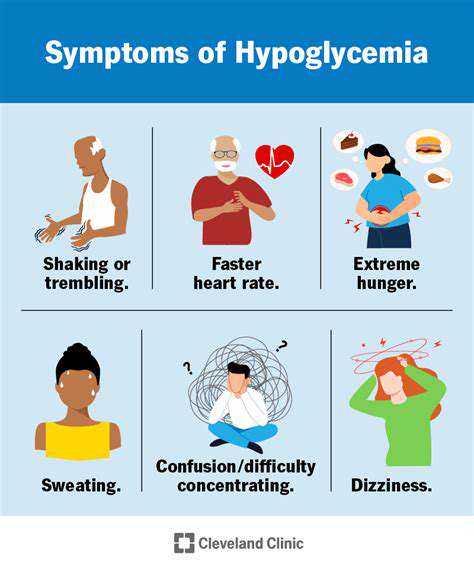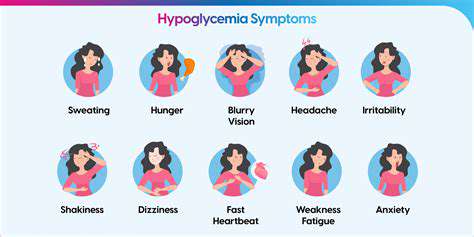How Low Blood Sugar Can Trigger Panic Attacks

Understanding the Connection
Hypoglycemia, or low blood sugar, can manifest in a variety of ways, impacting various bodily functions. One of these manifestations is the potential for triggering panic attacks. This connection is not fully understood, but research suggests a complex interplay of physiological and psychological factors. This interplay makes it challenging to pinpoint a single cause for the hypoglycemia-panic attack link.
The body's response to low blood sugar is multifaceted. The brain, relying heavily on glucose for energy, experiences a temporary disruption when blood sugar levels drop. This disruption can lead to a cascade of physiological reactions, including increased heart rate, rapid breathing, and sweating, all of which are characteristic of a panic attack. These physiological changes can create a vicious cycle, further amplifying the anxiety and fear.
Symptoms of Hypoglycemia and Panic Attacks
The symptoms of hypoglycemia and panic attacks can overlap significantly, making diagnosis challenging. Both conditions can present with rapid heartbeat, trembling, sweating, and difficulty breathing. This overlapping symptom profile can lead to misdiagnosis or delayed diagnosis, which can have serious consequences for the individual experiencing these episodes.
Recognizing the specific patterns and timelines of symptoms can be helpful in distinguishing between hypoglycemia and a panic attack. Often, a careful review of symptoms experienced, including any pre-existing conditions, can aid in accurate diagnosis. This is why it's crucial to seek professional medical help for accurate diagnosis and treatment.
Role of the Autonomic Nervous System
The autonomic nervous system plays a pivotal role in mediating the body's responses to both hypoglycemia and panic attacks. This system, responsible for involuntary functions like heart rate and breathing, is highly sensitive to changes in blood sugar levels. When blood sugar drops, the autonomic nervous system can react by initiating a fight-or-flight response, which is essentially the same physiological response as a panic attack.
This physiological response is essentially the body's attempt to restore balance. However, in cases of hypoglycemia, the trigger is low blood sugar, not an external threat. This can lead to the individual experiencing a panic attack-like response, even in the absence of a perceived threat.
Psychological Factors
Beyond the physiological aspects, psychological factors also contribute to the hypoglycemia-panic attack link. Individuals with pre-existing anxiety disorders or a history of panic attacks may be more susceptible to experiencing panic attacks in response to hypoglycemic episodes. This pre-existing anxiety can heighten the body's physiological response to low blood sugar, creating a feedback loop that intensifies the symptoms. Anxiety, stress, and even fear of hypoglycemia itself can all contribute to the cycle.
Managing and Preventing Episodes
Managing and preventing hypoglycemia episodes is crucial in mitigating the risk of panic attacks. Maintaining a consistent blood sugar level through a balanced diet, regular exercise, and medication (if necessary) can significantly reduce the likelihood of these episodes. Understanding your body's individual responses to hypoglycemia is essential in developing personalized coping strategies.
Seeking professional medical advice and working with a healthcare team to develop an individualized management plan can provide valuable support and guidance. This can also help to address any underlying anxiety or psychological factors that may be contributing to the problem.
Symptoms of Hypoglycemia That Mimic Panic Attacks

Early Warning Signs
Early symptoms of hypoglycemia, often mistaken for other conditions, can include feelings of shakiness, nervousness, and lightheadedness. These are frequently accompanied by a rapid heartbeat and sweating, which can be especially noticeable in individuals who are not used to experiencing these symptoms. It's crucial to recognize these early warning signs, as prompt treatment can prevent more severe complications.
Another early indicator is anxiety or irritability, potentially accompanied by difficulty concentrating. These symptoms can manifest in various ways, from mild restlessness to full-blown anxiety attacks. Understanding these early signs can aid in early intervention and prevent potentially dangerous situations.
Cognitive Impairment
As hypoglycemia progresses, more significant cognitive impairments may arise. This can include difficulty with thinking clearly, remembering things, and concentrating. Individuals experiencing these symptoms may also exhibit confusion or disorientation, making it challenging for them to perform everyday tasks safely.
Physical Symptoms
Significant physical symptoms can include problems with coordination and balance. This can lead to falls and other accidents, particularly in individuals who are unaware of the underlying cause. These physical symptoms are often accompanied by a significant impact on daily functioning.
Blurred vision or difficulty seeing clearly are also common indicators. Additionally, individuals may experience tingling or numbness in their extremities, which can be a sign that blood sugar levels are dangerously low. These symptoms can range from mild discomfort to severe impairment, highlighting the importance of prompt treatment.
Emotional Manifestations
Hypoglycemia can also manifest in emotional symptoms, including feelings of hunger, fatigue, or irritability. These emotions can sometimes be overwhelming and difficult to manage, particularly if the underlying cause isn't recognized. Recognizing the link between hypoglycemia and these emotional symptoms is critical for effective management.
Severe Symptoms
In severe cases, hypoglycemia can lead to seizures, loss of consciousness, and coma. These are undoubtedly the most serious symptoms and require immediate medical attention. The potential for these severe complications underscores the importance of understanding and managing hypoglycemia effectively.
Prompt diagnosis and treatment are crucial to prevent these life-threatening situations.
Symptoms in Children and Adolescents
Children and adolescents may experience hypoglycemia differently than adults, presenting with behavioral changes like mood swings, aggression, or even unusual sleepiness. It's essential for parents and caregivers to be aware of these variations in symptom presentation. Recognizing these behavioral changes in children can help in early detection and management of hypoglycemia.
These behavioral changes can be easily misinterpreted as typical adolescent behavior. Consequently, early detection and intervention are paramount to prevent potentially serious complications.
Differentiating Between Hypoglycemia and Panic Attacks
Recognizing the Symptoms
Hypoglycemia, or low blood sugar, and panic attacks can share some overlapping symptoms, making it challenging to distinguish between them. Both conditions can cause rapid heart rate, sweating, and trembling. However, understanding the nuances of these symptoms, and the accompanying circumstances, is crucial for accurate diagnosis. Paying attention to other potential symptoms, like difficulty concentrating or blurry vision, can help narrow down the possibility to hypoglycemia.
Panic attacks often involve a sense of impending doom or fear, along with intense physical sensations. Recognizing these feelings of overwhelming anxiety can help differentiate between the two conditions. Hypoglycemia, while causing physical symptoms, typically doesn't involve the same level of psychological distress or fear.
Blood Sugar Monitoring
One of the most effective ways to differentiate between hypoglycemia and a panic attack is through regular blood sugar monitoring. A simple finger-prick test can quickly determine blood glucose levels. Low blood sugar levels are a clear indicator of hypoglycemia, while normal or elevated blood sugar levels suggest a panic attack is the more likely cause of the symptoms.
Medical History
A thorough review of a person's medical history can be invaluable in determining the cause of their symptoms. Pre-existing conditions such as diabetes or other metabolic disorders strongly suggest a possibility of hypoglycemia. Knowledge of recent medications, dietary changes, or stressful life events can also provide clues to the underlying cause.
Physical Symptoms
While both hypoglycemia and panic attacks can present with rapid heart rate and sweating, paying attention to accompanying physical symptoms can provide important clues. Hypoglycemia may also include feelings of dizziness, hunger, or shakiness, whereas panic attacks may involve chest pain, shortness of breath, or tingling sensations.
Emotional Symptoms
Panic attacks are often characterized by intense fear and anxiety. These emotional symptoms are typically absent or significantly less pronounced with hypoglycemia. Hypoglycemia may cause irritability or confusion, but the overwhelming sense of dread and impending doom associated with panic attacks is generally not present.
Triggers and Timing
Identifying potential triggers for the symptoms can help determine the cause. For example, skipping meals or taking medication can trigger hypoglycemia, whereas stressful situations or specific environmental factors can precipitate panic attacks. Note the timing of symptoms relative to meals, medication, or stressful events to further differentiate the conditions.
Seeking Professional Help
If you're unsure whether your symptoms are due to hypoglycemia or a panic attack, seeking immediate medical attention is crucial. A healthcare professional can perform the necessary tests and evaluations to determine the underlying cause and provide appropriate treatment. Ignoring or misdiagnosing the condition can lead to serious complications.